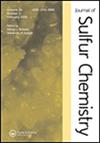一种具有多刺激反应性和染料吸附的新型四硫丁烯基有机凝胶
IF 1.6
3区 化学
Q3 CHEMISTRY, MULTIDISCIPLINARY
引用次数: 0
摘要
为了制备多刺激响应型有机凝胶,将两个具有酰胺功能的疏水链的光响应偶氮苯基与中心电活性四硫代戊烯(TTF)单元连接,合成了一种新型低分子量有机凝胶(LMMG) 1。综合评价了化合物1的胶凝性能,发现其具有固定1,2-二氯乙烷和正丁醇的能力,而其他溶剂均不能形成胶凝。通过扫描电镜(SEM)、红外光谱(FTIR)、核磁共振氢谱(1H NMR)和紫外/可见吸收光谱(UV/Vis absorption spectroscopy)对所得有机凝胶进行了表征。研究结果表明,凝胶在分子间氢键驱动下自组装成三维超分子网络。正如预期的那样,由于非共价相互作用的动态和可逆性质,有机凝胶在化学氧化还原条件、加热和阴离子存在的变化下表现出多种刺激响应的溶胶-凝胶转变。值得注意的是,凝胶与各种电子受体分子相互作用,导致电荷转移(CT)复合物和二元有机凝胶的形成,并伴有明显的颜色变化。此外,凝胶被证明是有效的吸收剂,这表明了从水中去除罗丹明B阳离子染料的潜在应用。本文章由计算机程序翻译,如有差异,请以英文原文为准。
A novel tetrathiafulvalene-based organogelator with multi-stimuli responsiveness and dye adsorption
To create multi-stimulus responsive organogels, a novel low-molecular-weight organic gelator (LMMG) 1 was synthesized by linking two photoresponsive azobenzene groups with two hydrophobic chains containing amide functionalities to a central electroactive tetrathiafulvalene (TTF) unit. The gelation properties of compound 1 were comprehensively evaluated, revealing its ability to immobilize 1,2-dichloroethane and n-butanol, while other solvents tested did not form gels. A series of analyses, including SEM, FTIR, 1H NMR, and UV/Vis absorption spectroscopy, were conducted to investigate the characteristics of the resulting organogels. The findings indicated that the gelator self-assembled into a three-dimensional supramolecular network, driven by intermolecular hydrogen bonding. As anticipated, the organogels displayed multiple stimuli-responsive sol–gel transitions in response to changes in chemical redox conditions, heating, and the presence of anions due to the dynamic and reversible nature of the non-covalent interactions. Notably, the gelators interacted with various electron acceptor molecules, resulting in the formation of charge transfer (CT) complexes and binary organogels, accompanied by noticeable color changes. Additionally, the gels proved to be effective absorbents, suggesting potential applications for the removal of Rhodamine B cationic dyes from water.
求助全文
通过发布文献求助,成功后即可免费获取论文全文。
去求助
来源期刊

Journal of Sulfur Chemistry
CHEMISTRY, MULTIDISCIPLINARY-
CiteScore
4.10
自引率
9.10%
发文量
38
审稿时长
6-12 weeks
期刊介绍:
The Journal of Sulfur Chemistry is an international journal for the dissemination of scientific results in the rapidly expanding realm of sulfur chemistry. The journal publishes high quality reviews, full papers and communications in the following areas: organic and inorganic chemistry, industrial chemistry, materials and polymer chemistry, biological chemistry and interdisciplinary studies directly related to sulfur science.
Papers outlining theoretical, physical, mechanistic or synthetic studies pertaining to sulfur chemistry are welcome. Hence the target audience is made up of academic and industrial chemists with peripheral or focused interests in sulfur chemistry. Manuscripts that truly define the aims of the journal include, but are not limited to, those that offer: a) innovative use of sulfur reagents; b) new synthetic approaches to sulfur-containing biomolecules, materials or organic and organometallic compounds; c) theoretical and physical studies that facilitate the understanding of sulfur structure, bonding or reactivity; d) catalytic, selective, synthetically useful or noteworthy transformations of sulfur containing molecules; e) industrial applications of sulfur chemistry; f) unique sulfur atom or molecule involvement in interfacial phenomena; g) descriptions of solid phase or combinatorial methods involving sulfur containing substrates. Submissions pertaining to related atoms such as selenium and tellurium are also welcome. Articles offering routine heterocycle formation through established reactions of sulfur containing substrates are outside the scope of the journal.
 求助内容:
求助内容: 应助结果提醒方式:
应助结果提醒方式:


